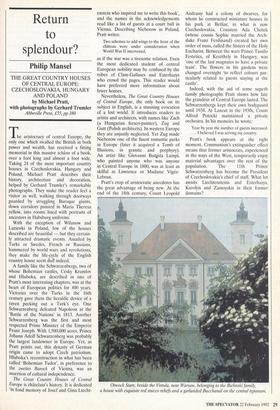Return to splendour?
Philip Mansel
THE GREAT COUNTRY HOUSES OF CENTRAL EUROPE: CZECHOSLOVAKIA, HUNGARY AND POLAND by Michael Pratt, with photographs by Gerhard Trumler
Abbeville Press, 135, pp.380
The aristocracy of central Europe, the only one which rivalled the British in both power and wealth, has received a fitting memorial in this massive schloss of a book, over a foot long and almost a foot wide. Taking 24 of the most important country houses in Czechoslovakia, Hungary and Poland, Michael Pratt describes their history, architecture and decoration, helped by Gerhard Trumler's remarkable photographs. They make the reader feel a visitor as well, walking through doorways guarded by struggling Baroque giants, down corridors painted in Maria Theresa yellow, into rooms lined with portraits of ancestors in Habsburg uniforms.
With the exception of Wilanow and Lazienki in Poland, few of the houses described are beautiful — but they certain- ly attracted dramatic events. Assailed by Turks or Swedes, French or Russians, hammered by world wars and revolutions, they make the life-cycle of the English country house seem Butt indeed.
A family like the Schwarzenbergs, two of whose Bohemian castles, Cesky Krumlov and Hluboka, are described in one of Pratt's most interesting chapters, was at the heart of European politics for 400 years. Victories over the Turks in the 16th century gave them the heraldic device of a raven pecking out a Turk's eye. One Schwarzenberg defeated Napoleon at the `Battle of the Nations' in 1813. Another Schwarzenberg was the first and most respected Prime Minister of the Emperor Franz Joseph. With 1,500,000 acres, Prince Johann Adolf Schwarzenberg was probably the largest landowner in Europe. Yet, as Pratt points out, this dynasty of German origin came to adopt Czech patriotism. Hluboka's reconstruction in what has been called 'Bohemian Tudor', in preference to the zweites Barock of Vienna, was an assertion of cultural independence.
The Great Country. Houses of Central Europe is chatelain's history. It is dedicated 'in fond memory of Josef and Gina Liecht-
enstein who inspired me to write this book', and the names in the acknowledgements read like a list of guests at a court ball in Vienna. Describing Nieborow in Poland, Pratt writes:
Two schemes to add wings to the front of the château were under consideration when World War II intervened,
as if the war was a tiresome relation. Even the most dedicated student of central European nobility may be confused by the tribes of Clam-Gallases and Esterhazys who crowd the pages. This reader would have preferred more information about fewer houses.
Nevertheless, The Great Country Houses of Central Europe, the only book on its subject in English, is a stunning evocation of a lost world. It introduces readers to artists and architects, with names like Zach (a Hungarian fresco-painter), Zug and Gutt (Polish architects). In western Europe they are unjustly neglected. Yet Zug made Nieborow one of the finest romantic parks in Europe (later, it acquired a Tomb of Illusions, in granite and porphyry). An artist like Giovanni Batista Lampi, who painted anyone who was anyone in Central Europe in 1800, was at least as skilful as Lawrence or Madame Vigde- Lebrun.
Pratt's crop of aristocratic anecdotes has the great advantage of being new. At the end of the 18th century, Count Leopold Andrassy had a colony of dwarves, for whom he constructed miniature houses in his park at Betliar, in what is now Czechoslovakia. Countess Ada Chotek (whose cousin Sophie married the Arch- duke Franz Ferdinand) created her own order of nuns, called the Sisters of the Holy Eucharist. Betweeti the wars Prince Tassilo Festetics, of Keszthely in Hungary, was `one of the last magnates to have a private train'. The flowers in his gardens were changed overnight 'to reflect colours par- ticularly related to guests staying at the castle'.
Indeed, with the aid of some superb family photographs Pratt shows how late the grandeur of Central Europe lasted. The Schwarzenbergs kept their own bodyguard until 1938. At Lancut in the 1930s, Count Alfred Potocki maintained a private orchestra. In his memoirs he wrote:
Year by year the number of guests increased. ... I believed I was serving my country.
Pratt's book appears at the right moment. Communism's extinguisher effect means that former aristocrats, experienced in the ways of the West, temporarily enjoy material advantages over the rest of the population. The 1 1 th Prince Schwarzenberg has become the President of Czechoslovakia's chief of staff. What lot awaits Liechtensteins and Esterhazys, Karolyis and Zamoyskis in their former domains?
Otwock Stary, beside the Vistula, near Warsaw, belonging to the Bielinski family, a house with exquisite red stucco reliefs and a garlanded Bacchanal on the central typanum.


















































 Previous page
Previous page